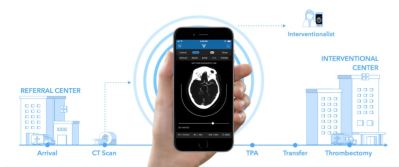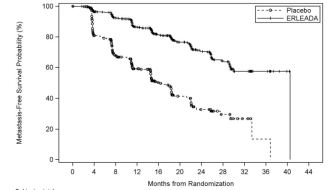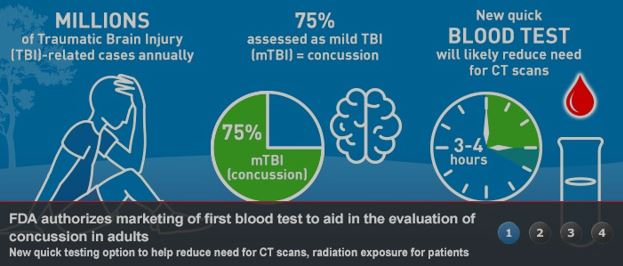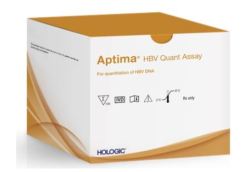
ContaCT
Viz.AI
INDICATION FOR USE:
Notification-only, parallel workflow tool for use by hospital networks, trained clinicians to identify and communicate images of specific patients to a specialist, independent of standard of care workflow.
Uses an artificial intelligence (AI) algorithm to analyze images for findings suggestive of a prespecified clinical condition and to notify an appropriate medical specialist of these findings in parallel to standard of care image interpretation. Identification of suspected findings is not for diagnostic use beyond notification. Specifically, the device analyzes CT angiogram images of the brain acquired in the acute setting, and sends notifications to a neurovascular specialist that a suspected large vessel occlusion has been identified and recommends review of those images. Images can be previewed through mobile application.
Images that are previewed through the mobile application are compressed and are for informational purposes only and not intended for diagnostic use beyond notification. Notified clinicians are responsible for viewing non-compressed images on a diagnostic viewer and engaging in appropriate patient evaluation and relevant discussion with a treating physician before making care-related decisions or requests. ContaCT is limited to analysis of imaging data and should not be used in-lieu of full patient evaluation or relied upon to make or confirm diagnosis.
ADDRESSING UNMET NEED:
- First approved Clinical Decision Software to analyze computed tomography (CT) results that may notify providers of stroke potential
- 795,000 in U.S. have stroke each year; causes serious and irreversible damage
- Software device notifies specialist earlier thereby decreasing the time to treatment
DEVICE DESCRIPTION:
- Computer-aided triage software using AI algorithm to analyze images for stroke indicators
- Designed to analyze brain CT images
- Send text notification to neurovascular specialist if suspected large vessel blockage
- Involve specialist sooner with algorithm automatically notifying specialist concurrently with first-line provider who is conducting standard review of images
- Specialist still needs to review images on clinical workstation
ALGORITHM & NOTIFICATION PERFORMANCE:
- Retrospective study of 300 CT images
- Brain large vessel blockage detection: Algorithm image analysis and notification vs. performance of two trained neuro-radiologists
- Real-world evidence used with clinical study to demonstrate neurovascular specialist notification sooner in cases of suspected blockage
REGULATORY PATHWAY: De Novo
- 21 CFR 892.2080
- Regulation Name: Radiological Computer Aided Triage and Notification Software
- Class II, Product Code: QAS
GENERIC DEVICE TYPE: Radiological computer aided triage and notification software
- Image processing device intended to aid in prioritization and triage of radiological medical image
- Notifies designated list of clinicians of the availability of time sensitive radiological medical images for review based on computer aided image analysis of those images performed by the device
- Does not mark, highlight, or direct users’ attention to a specific location in original image
- Does not remove cases from a reading queue
- Operates in parallel with standard of care, which remains default option for all cases
SPECIAL CONTROLS:
- Detailed description of notification and triage algorithms
- Detailed description of pre-specified performance testing protocols and dataset(s) used to assess whether the device will provide effective triage
- Performance testing
- Appropriate software documentation
- Labeling
IDENTIFIED RISKS:
- Failure to prioritize images for review with positive findings may result in incorrect and/or delayed patient management
- Positive notifications may result in deprioritization of review of images from other patients
- Misuse to analyze images (unintended patient population, incompatible imaging
hardware and image acquisition) - Device failure leading to absence, delay, incorrect results
- Inappropriate use of triage and notification outputs
- Mitigated by general and special controls
REIMBURSEMENT
- Precedence for CMS qualification of Clinical Decision Support Mechanisms
 ERLEADA (apalutamide) tablets
ERLEADA (apalutamide) tablets
Janssen
INDICATION: Treatment of patients with non-metastatic, castration-resistant prostate cancer (NM-CRPC)
ADDRESSING UNMET NEED:
- Prostate cancer is second most common form of cancer in men; 161,360 men diagnosed-26,730 expected to die of disease
- 10 to 20 % cases are castration-resistant; up to 16% show no evidence of metastasis at the time of castration-resistant diagnosis
- First approval based on endpoint of metastasis-free survival
MECHANISM OF ACTION: Androgen Receptor (AR) inhibitor, inhibits AR nuclear translocation, inhibits DNA binding, and impedes AR-mediated transcription
EFFICACY:
- Single multicenter, double-blind, clinical trial, n= 1,207 patients with NM-CRPC, ERLEADA vs placebo
- Major efficacy outcome: Metastasis-free survival (MFS), time to metastasis (TTM), progression-free survival (PFS) and overall survival (OS)

- Significant improvement in MFS: 40.5 months vs 16. 2 months, HR=0.28, CI: 0.23, 0.35;p<0.0001
SAFETY:
- Most common adverse reactions : Fatigue, hypertension, rash, diarrhea, nausea, weight decreased, arthralgia, fall, hot flush, decreased appetite, fracture, and peripheral edema
REGULATORY PATHWAY: NDA, Priority Review
- Pediatric requirements waived
REIMBURSEMENT
- CMS covers prostate CA drugs
- Novel and clinically meaningful endpoint could secure favorable coverage and pricing
 BANYAN Brain Trauma Indicator
BANYAN Brain Trauma Indicator
Banyan Biomarkers, Inc.
INDICATION FOR USE:
In vitro diagnostic chemiluminescent enzyme-linked immunosorbent assay (ELISA). Assay provides semi-quantitative measurement of the concentrations of ubiquitin Cterminal hydrolase-L1 (UCH-L1) and glial fibrillary acidic protein (GFAP) in human serum, and is used with the Synergy 2 Multi-mode Reader.
The assay results obtained from serum collected within 12 hours of suspected head injury are used, along with other available clinical information, to aid in the evaluation of patients 18 years of age and older with suspected traumatic brain injury (TBI, Glasgow Coma Scale score 13-15). A negative assay result is associated with the absence of acute intracranial lesions visualized on a head CT (computed tomography) scan.
The Banyan BTI is for prescription use only.
ADDRESSING UNMET NEED:
- 2.8 million TBI-related emergency department visits, hospitalizations, deaths in US
- Need for innovative testing technologies that minimize health impacts
- Supports FDA Initiative to Reduce Unnecessary Radiation Exposure from Medical Imaging
- Blood-testing option for TBI/concussion is a new tool, modernizing standard of and likely reduce CT scans performed
GENERIC DEVICE TYPE: Brain trauma assessment test
- Consists of reagents used to detect and measure brain injury biomarkers in human specimens
- Measurements aid in evaluation of patients with suspected mild traumatic brain injury in conjunction with other clinical information to assist in determining the need for head imaging per current standard of care
EFFECTIVENESS:
- Multi-center, prospective clinical study, n=1,947 individual blood samples from adults with suspected TBI/concussion
- Comparison TBI/concussion blood tests results vs CT scan results
- Prediction: 97.5% accuracy (presence of lesions), 99.6% accuracy (absence of lesions
REGULATORY PATHWAY: De Novo
- Approval in <6 months as part of its Breakthrough Devices Program
- 21 CFR 866.5830
- Regulation Name: Brain trauma assessment test
- Class II, Product Code: QAT
SPECIAL CONTROLS:
- Performance testing including clinical testing
- Labeling
RISKS
- Inaccurate test results that provide false positive or false negative results
- Failure to correctly interpret test results can lead to false positive or false negative results
- Mitigated by general and special controls
 APTIMA HBV Quant Assay
APTIMA HBV Quant Assay
Hologic, Inc
INDICATION FOR USE:
In vitro nucleic acid amplification test for the quantitation of hepatitis B virus (HBV) DNA in human plasma and serum on the fully automated Panther® system.
Plasma may be prepared in ethylenediaminetetraacetic acid (EDTA), anticoagulant citrate dextrose (ACD) solution, and plasma preparation tubes (PPTs). Serum may be prepared in serum tubes and serum separator tubes (SSTs). Specimens are tested using the fully automated Panther system for sample processing, amplification, and quantitation. Specimens containing HBV genotypes A, B, C, D, E, F, G, and H are validated for quantitation in the assay.
The Aptima HBV Quant assay is intended for use as an aid in the management of patients with chronic HBV infections undergoing HBV antiviral drug therapy. The assay can be used to measure HBV DNA levels at baseline and during treatment to aid in assessing viral response to treatment. The results from the Aptima HBV Quant assay must be interpreted within the context of all relevant clinical and laboratory findings. Assay performance for determining the clinical stage of HBV infection has not been established. Clinical performance characteristics have been established for individuals treated with tenofovir disoproxil fumarate or entecavir.
The Aptima HBV Quant assay is not approved for use as a screening test for the presence of HBV DNA in blood or blood products or as a diagnostic test to confirm the presence of HBV infection
ADDRESSING UNMET NEED:
- Hepatitis B is a liver infection caused by HBV; transmitted through infected blood, semen, or other body fluid
- Risk for chronic infection is related to age at infection: ~ 90% of infected infants become chronically infected, vs. 2%–6% of adults
- Chronic Hepatitis B infection can lead to cirrhosis or liver cancer
DESCRIPTION:
- In vitro nucleic acid amplification test with real time transcription-mediated amplification (TMA) technology on Panther system
- Standardized to the 3rd WHO International Standard for Hepatitis B Virus
- Three main steps which all take place in a single tube on the Panther system: (1) target capture, (2) target amplification by TMA, (3) detection of amplification products (amplicon) by fluorescent labeled probes
EFFECTIVENESS AND SAFETY:
- Effectiveness demonstrated when used for the quantitation of HBV DNA in human plasma and serum and serum separation tubes for management of patients undergoing treatment.
- Clinical performance evaluated in ethnically diverse population representative of intended use population
- Accurately measures viral load in patient at baseline and at intervals during antiviral therapy
- Should benefit physician and patients in management of chronic HBV infected individuals undergoing antiviral therapy when used according to the directions for use in labeling
REGULATORY PATHWAY: PMA
- Product Code: MKT
REIMBURSEMENT
- CMS has determined that screening for HBV infection is reasonable and necessary for the prevention or early detection
- Will cover screening for HBV infection with FDA approved/cleared laboratory tests, used consistent with FDA approved labeling and in compliance with CLIA regulations Decision memo
Image credit: Viz.AI, Banyan, Janssen, Hologic